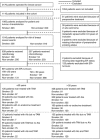Impacts of smoking on endocrine treatment response in a prospective breast cancer cohort
- PMID: 27280635
- PMCID: PMC4973149
- DOI: 10.1038/bjc.2016.174
Impacts of smoking on endocrine treatment response in a prospective breast cancer cohort
Abstract
Background: The association between smoking and breast cancer prognosis remains unclear. The purpose of this study was to investigate whether preoperative smoking was associated with prognosis in different treatment groups.
Methods: This population-based cohort consisted of 1065 breast cancer patients without preoperative treatment included between 2002 and 2012 in Lund, Sweden. Smoking status was examined in relation to patient and tumour characteristics, and prognosis in different treatment groups.
Results: At the preoperative visit, 21.0% smoked. Median follow-up time was 5.1 years. Overall, in the 1016 patients included in the survival analyses, there was no significant association between smoking and risk of breast cancer events (adjusted hazard ratio (adjHR): 1.45; 95% confidence interval (CI): 0.95-2.20). For the 309 aromatase inhibitor (AI)-treated patients ⩾50 years with oestrogen receptor-positive (ER+) tumours, smoking was associated with risk of breast cancer events (adjHR: 2.97; 95% CI: 1.44-6.13), distant metastasis (adjHR: 4.19; 95% CI: 1.81-9.72), and death (adjHR: 3.52; 95% CI: 1.59-7.81). Smoking was not associated with breast cancer events or distant metastasis in other treatment groups.
Conclusions: Preoperative smoking was only associated with an increased risk for breast cancer events and distant metastasis in AI-treated patients. If confirmed, smoking status should be taken into consideration when selecting an endocrine therapy.
Figures




Similar articles
-
History of oral contraceptive use in breast cancer patients: impact on prognosis and endocrine treatment response.Breast Cancer Res Treat. 2015 Jan;149(2):505-15. doi: 10.1007/s10549-014-3252-8. Epub 2015 Jan 4. Breast Cancer Res Treat. 2015. PMID: 25556354
-
Adjuvant letrozole versus tamoxifen according to centrally-assessed ERBB2 status for postmenopausal women with endocrine-responsive early breast cancer: supplementary results from the BIG 1-98 randomised trial.Lancet Oncol. 2008 Jan;9(1):23-8. doi: 10.1016/S1470-2045(07)70386-8. Epub 2007 Dec 20. Lancet Oncol. 2008. PMID: 18083065 Clinical Trial.
-
CYP1A2--a novel genetic marker for early aromatase inhibitor response in the treatment of breast cancer patients.BMC Cancer. 2016 Mar 31;16:256. doi: 10.1186/s12885-016-2284-3. BMC Cancer. 2016. PMID: 27029552 Free PMC article.
-
Reducing the risk for breast cancer recurrence after completion of tamoxifen treatment in postmenopausal women.Clin Ther. 2007 Aug;29(8):1535-47. doi: 10.1016/j.clinthera.2007.08.013. Clin Ther. 2007. PMID: 17919537 Review.
-
A review of the BIG results: the Breast International Group 1-98 trial analyses.Breast. 2008 Jan;17 Suppl 1:S9-S14. doi: 10.1016/S0960-9776(08)70003-1. Breast. 2008. PMID: 18279765 Review.
Cited by
-
Increasing preoperative body size in breast cancer patients between 2002 and 2016: implications for prognosis.Cancer Causes Control. 2018 Jul;29(7):643-656. doi: 10.1007/s10552-018-1042-z. Epub 2018 May 26. Cancer Causes Control. 2018. PMID: 29804217 Free PMC article.
-
Impact of combining vitamin C with radiation therapy in human breast cancer: does it matter?Oncotarget. 2022 Feb 22;13:439-453. doi: 10.18632/oncotarget.28204. eCollection 2022. Oncotarget. 2022. PMID: 35222809 Free PMC article.
-
Interactions Between ABCB1 Genotype and Preoperative Statin Use Impact Clinical Outcomes Among Breast Cancer Patients.Front Oncol. 2018 Oct 12;8:428. doi: 10.3389/fonc.2018.00428. eCollection 2018. Front Oncol. 2018. PMID: 30370250 Free PMC article.
-
Survival Benefits of Smoking Cessation After Breast Cancer Diagnosis.JNCI Cancer Spectr. 2017 Sep 21;1(1):pkx005. doi: 10.1093/jncics/pkx005. eCollection 2017 Sep. JNCI Cancer Spectr. 2017. PMID: 31360831 Free PMC article. No abstract available.
-
Prediagnostic Smoking Is Associated with Binary and Quantitative Measures of ER Protein and ESR1 mRNA Expression in Breast Tumors.Cancer Epidemiol Biomarkers Prev. 2018 Jan;27(1):67-74. doi: 10.1158/1055-9965.EPI-17-0404. Epub 2017 Nov 13. Cancer Epidemiol Biomarkers Prev. 2018. PMID: 29133365 Free PMC article. Clinical Trial.
References
-
- Abramowitz MC, Li T, Morrow M, Anderson PR, Bleicher RJ, Goldstein LJ, Swaby R, Nicoloau N, Freedman GM (2010) History of smoking is associated with younger age at diagnosis of breast cancer. Breast J 16: 344–349. - PubMed
-
- Baglietto L, English DR, Hopper JL, MacInnis RJ, Morris HA, Tilley WD, Krishnan K, Giles GG (2009) Circulating steroid hormone concentrations in postmenopausal women in relation to body size and composition. Breast Cancer Res Treat 115: 171–179. - PubMed
Publication types
MeSH terms
Substances
LinkOut - more resources
Full Text Sources
Other Literature Sources
Medical

